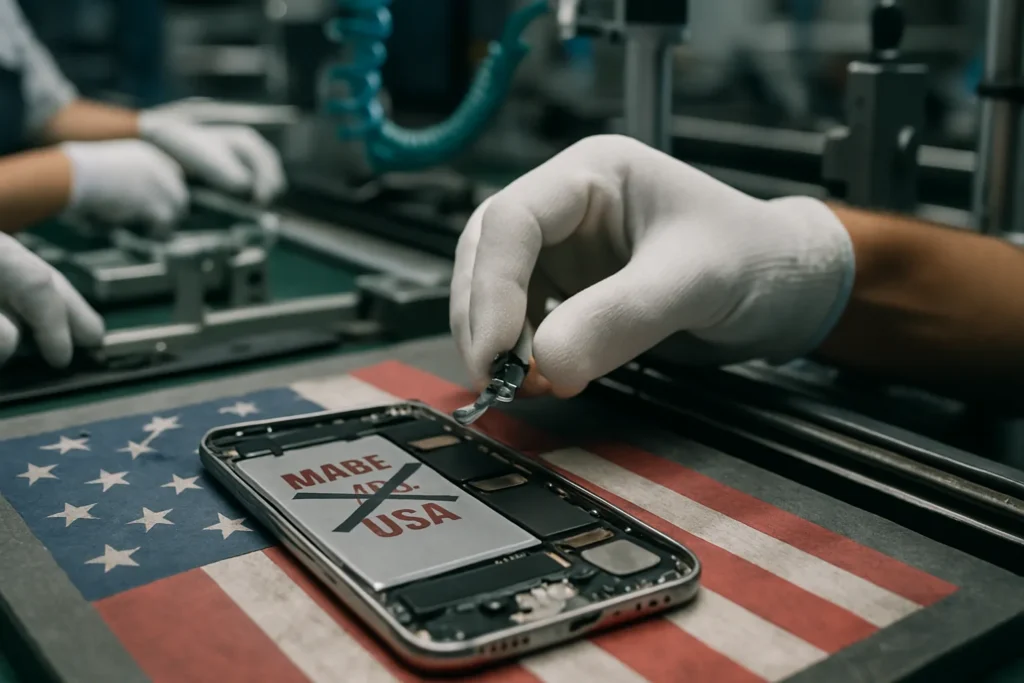False Starts and Fading Promises: The Trump T1 Debacle
Patriotic branding has long been a staple of Donald Trump’s business ventures. How many times have we seen the Trump name presented as a guarantee of American greatness—on hotels, steaks, wine, and now, on a glossy new smartphone? Yet, the launch of the Trump Mobile T1 has exposed the staggering gap between American manufacturing fantasies and global economic realities.
Just days after its grand unveiling, Trump Mobile scrubbed all references to the T1’s supposedly American origins from its website. The original bold, unmistakable claims—”Made in the USA”—quietly disappeared, replaced by platitudes like “Proudly American” and “Brought to life right here in the USA.” The retreat was swift but telling. Once media scrutiny intensified, and questions mounted regarding the feasibility of making sophisticated smartphones on US soil, the facade crumbled.
The Internet pounced. Commentators, supply chain experts, and fact-checkers—such as CNN tech analyst Max Weinbach—pointed out the obvious: virtually no smartphones are manufactured in the United States at scale. The global electronics supply chain simply doesn’t support it. “The only smartphone manufacturers capable of producing in the quantities and at the prices Trump Mobile advertises are based in China”, Weinbach observed. In fact, analyst Dan Ives of Wedbush Securities estimated that an American-made smartphone could cost as much as $3,500 per unit, about seven times the T1’s advertised $499 price tag (The Verge, June 2024).
Can you imagine paying over $3,000 for a smartphone just for the sake of a “Made in America” label? The country loves an underdog story, yet economic reality delivers a sobering counter-narrative.
The Rhetoric of Nationalism versus Manufacturing Reality
Why, then, persist in this charade? The political utility of patriotic hype cannot be underestimated. For the Trump Organization, the T1 wasn’t just a phone—it was a statement about reclaiming American greatness, a campaign echo transformed into a product promise. From campaign-trail speeches to business launches, Donald Trump has insisted that “America First” means keeping jobs, technologies, and manufacturing within US borders.
But when the rubber meets the road—or, in this case, the microchip meets the motherboard—aspiration hits a wall. Domestic high-tech manufacturing is a labyrinth of complexity. The supply chains for advanced electronics were long ago outsourced to Asia, especially China, where economies of scale, expertise, and infrastructure have all converged to make onshore alternatives economically and logistically daunting.
Harvard Business School professor Willy Shih, an expert in manufacturing strategy, told The Wall Street Journal that “hopes for large-scale smartphone production in the U.S. are unrealistic for the foreseeable future” due to the country’s lack of crucial component fabrication plants and skilled labor at scale.
In the face of these obstacles, Eric Trump, speaking on Fox Business, tried a delicate tap dance: the first T1 phones might not be American-made, he said, but “eventually all the phones can be built in the United States of America.” Such a claim drips with ambition—and disingenuousness. History is littered with political promises that outpace the underlying technology and infrastructure; what matters isn’t just intent, but viable execution.
“For all the grandiose talk of reshoring, the facts remain stubborn: high-tech manufacturing isn’t easily reclaimed in a globalized economy built on complex, cost-efficient supply chains.”
Big talk about “American hands behind every device” may placate the base, but it rings hollow in the bright light of public scrutiny. Beneath the surface, the T1 is likely a white-label version of a Chinese-made handset—perhaps a rebadged REVVL 7 Pro 5G, according to reporting by supply chain sleuths.
What the Episode Reveals About Conservative Economic Promises
Strip away the bluster, and the Trump Mobile saga offers a cautionary lesson on the limitations of simplistic economic slogans. Critics of conservative industrial policy often warn that mere rhetoric cannot overcome decades of offshoring, regulatory gaps, and the allure of cheap labor overseas. The smartphone debacle is a microcosm of these deeper fault lines.
Progressive thinkers argue for robust investment in American manufacturing, but they also recognize that the path requires real commitment: workforce training, public-private partnerships, environmental standards, and, yes, a willingness to pay more for domestically produced goods. Shifting supply chains home isn’t a matter of hashtags and soundbites—it’s a multi-decade endeavor requiring bipartisan buy-in and nuanced solutions.
The T1’s vanishing “Made in USA” promise reads less like a glitch and more like an inevitable consequence of policy hypocrisy—where politicians rail against outsourcing yet capitalize on globalized supply chains the moment profit is at stake. This isn’t new; decades ago, Ronald Reagan’s own attempts to revive US manufacturing were stymied by the lure of lower costs abroad. Today, despite MAGA hats made in China and now the Trump phone’s mysterious origins, the pattern persists.
Consumers, meanwhile, are caught in the crossfire: sold grand dreams but delivered cut-rate reality. Wouldn’t it be better, for both companies and citizens, to have honest conversations about what it truly takes to rebuild American industry instead of fleeting, unfulfilled promises?
Pew Research Center polling from 2023 found that while 75% of Americans support efforts to reshore critical manufacturing, only 30% are willing to pay significant price premiums for US-made goods—an economic catch-22 that politicians rarely address head-on.
The Trump Mobile escapade underscores a broader truth: meaningful economic progress is grounded in candor, investment, and planning—not just branding. Until leaders, left and right, face these realities, Americans will be left with empty slogans and, it seems, foreign-assembled smartphones stamped with red, white, and blue bravado.

